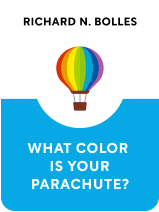

This article is an excerpt from the Shortform book guide to "What Color Is Your Parachute?" by Richard N. Bolles. Shortform has the world's best summaries and analyses of books you should be reading.
Like this article? Sign up for a free trial here .
Do you know how to apply the principles of What Color Is Your Parachute? Can you use a What Color Is Your Parachute test?
The What Color Is Your Parachute test is about identifying your ideal job. This test includes worksheets for working environment, location, what you can do, and what you get out of your job.
Keep reading for 6 worksheets in the What Color Is Your Parachute test.
What Color Is Your Parachute Test
Worksheet #1: Ideal Environments
This is the first worksheet of the What Color Is Your Parachute test. It involves reflecting on what you don’t like and then considering the opposite.
On a scrap piece of paper, create a chart with the following four columns:
| Column A: Jobs you’ve had so far. | Column B: Working conditions you don’t like, in any order. | Column C: Top five worst working conditions. | Column D: Top five best working conditions. |
| Here, write a list of all the jobs you’ve ever held. | Here, write a list of ten conditions that you didn’t like working in and/or that decreased your productivity. For example, perhaps you didn’t like working in an office that was near a door because every time it slammed loudly, it distracted you. | Here, write the worst five items from column B in order of priority. Use the prioritizing grid. | Here, write the opposite of the items in column C. Again, you don’t have to write the exact opposite. For example, you might write “quiet” instead of “not beside the door.” |
Worksheet #2: What Are Your Functional Skills?
Most people don’t know what their functional skills are, but it is an important part of the What Color Is Your Parachute test. If you do know, write them directly on your flower diagram. If you don’t, do this exercise. Here are the steps:
1. Write seven stories about seven moments in your life. Don’t choose something big like graduating from college; instead, choose a brief moment that you enjoyed. When choosing, consider, for example, stories that: aren’t work-related, demonstrate you acting differently than you normally would, or are difficult, exciting, unusual, or fun. If you really can’t think of anything, describe jobs or roles that you’ve enjoyed. Each story should have:
- A goal.
- For example, you adopted a puppy and wanted to train her as a therapy dog.
- An obstacle you had to overcome.
- The puppy was hard to train.
- The process you used to overcome the obstacle and achieve the goal.
- You researched dog training, signed yourself and the puppy up for a course, and signed up for the certification exam.
- The outcome.
- The puppy passed the exam and started working as a therapy dog at the children’s hospital.
- A statement about the outcome.
- You learned a lot about dog training and love that you did something to help sick children.
2. Carefully reread each story and figure out what functional skills you used in each to achieve your goals. For example, in the puppy story, you used some of the following skills: train, research, solve problems.
3. Look for a pattern of which functional skills keep recurring. Assuming that you followed the guideline to write stories about truly enjoyable moments, these are your favorite skills because you keep using them.
- For example, some people-related skills you might have employed are to: heal, instruct, counsel, communicate, or serve.
- Some information-related skills you might have employed are to: imagine, analyze, research, problem-solve, or compare.
- Some thing-related skills you might have employed are to: repair, drive, manufacture, restore, or carve.
4. Prioritize functional skills. Narrow the list down to your ten favorite skills (the ones you like exercising, not the ones you think will be most useful). Then, use the prioritizing grid to put them in order of importance.
5. Qualify functional skills with traits and objects. Create a list of your strongest traits. Remember that traits describe how you do things, for example, how you communicate. (To come up with the list, you can take a Myers-Briggs test, or take a Values-in-Action assessment.) Then, combine your traits and skills and add an object if necessary. For example, if the skill is “communicate,” you might specify that you can “communicate authoritatively with children.” These phrases will be your go-tos during job interviews.
- Expressing your traits as adverbs (like “authoritatively”) makes it easier to combine your traits and skills into a single phrase (like “communicate authoritatively”). Some examples of traits in the form of adverbs are: energetically, tactfully, objectively, punctually, and versatilely.
Worksheet #3: Determine Desirable Geographic Factors
On a scrap piece of paper, create a chart with the following four columns:
| Column A: List the place you’ve lived. | Column B: What did you dislike about the places you lived? | Column C: What do you like in a location? | Column D: What are your top ten factors? |
| Here, write the list. | Here, write things that you didn’t enjoy. They don’t have to be written beside the name of the places, and if things come up multiple times, add a checkmark for each instance rather than repeating the factor. | Here, list anything you liked about the places you’ve lived. Also list opposites, or near-opposites, of all the things in column B. | Here, list the most important factors in a place to live. Use the prioritizing grid. |
If you’re doing this worksheet with your partner, get them to fill out the chart too. Their opinion on this is part of the What Color Is Your Parachute test. Then, together, make a list of your top twenty factors, alternating your and your partner’s factors in priority sequence. For example, your top factor is somewhere sunny and her top factor is somewhere French-speaking, write French-speaking, then sunny, then move on to both of your second-most-important factors. Stop after ten factors.
Worksheet #4: What Level Do You Want to Work At?
Your job level is related to your salary—the more responsibilities you have, the more you’re paid. Ask yourself how much responsibility do you want? Do you want to be the boss, a manager, a team member? Write down a two- or three-word description on Petal #5.
Worksheet #5: What Salary Range Do You Want?
The minimum number in your salary range is what you’d need to survive. To find that out, create a budget that states what you’re currently spending. Figure out how much you spend in each of the following categories. Add any categories that you feel are missing:
- Housing, including rent/mortgage, utilities, and so on
- Food, including groceries, restaurants, and so on
- Clothes, including buying clothes and laundry
- Transportation, including car payments, gas, repairs, bus passes, parking, and so on
- Insurance, including car, home, medical, life, and so on
- Health, including appointments, gym memberships, prescriptions, and so on
- Support, including daycare, home care for elderly relatives, pets, and so on
- Donations
- Education, including your own or your family’s
- Bills, including credit cards
- Taxes, including local, state, and federal, and tax services. Note that sometimes you can claim job-searching costs
- Savings, including for retirement
- Fun, including concert tickets, cable, and so on
Once you’ve come up with a monthly amount, multiply it by 12 to get the yearly amount and then divide it by 2,000 to find out how much you’d need to make per hour to support that budget.
The maximum number in your salary range should be the highest realistic salary a generous boss would give you. To find that out, redo your budget with the numbers you’d like to be spending in each of the categories.
Transfer the minimum and maximum numbers to Petal #6.
Worksheet #6: Factors Besides Money
This is an optional worksheet in the What Color Is Your Parachute test. Because money only buys happiness up to a point, you might want to consider what else you can get out of a job besides salary. Consider things such as respect, challenge, fame, or opportunities to do things such as be creative or help others.

———End of Preview———
Like what you just read? Read the rest of the world's best book summary and analysis of Richard N. Bolles's "What Color Is Your Parachute?" at Shortform .
Here's what you'll find in our full What Color Is Your Parachute? summary :
- How to not just find a job, but find a job you love
- Why traditional resumes don’t find you the right job
- The 7 steps to identifying your ideal career






